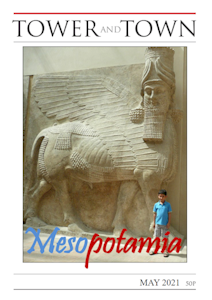

Tower and Town, May 2021 (view the full edition) (view the full edition)The Story Of GilgameshThe discovery of the story of Gilgamesh around 150 years ago in Mesopotamia was sensational. The most complete version was discovered by the British archaeologist Layard at Nineveh, inscribed on clay tablets dating from the 7th century BC. But earlier sections of the same story, dating from between 1800 and 1300 BC, were discovered on tablets at other sites, thus making the epic the oldest literature known to us. Scholarly thinking reckons that an even earlier version existed before 2000 BC. Gilgamesh was the heroic King of Uruk, with some divine ancestry, but with an arrogant attitude towards the gods as well as towards his own people. With his best friend and companion, the wild man Enkidu, whom contact with women had civilized, Gilgamesh journeys to the forbidden Cedar Forest, where they kill the guardian and cut down several cedars. Angered, the goddess Ishtar sends the great Bull of Heaven against them and Gilgamesh's kingdom; they kill the bull, but in revenge for this Enkidu has to die. Devastated by his friend's death, Gilgamesh sets out on a vast journey beyond the ends of the earth to seek wisdom from an old man reputed to have found everlasting life. After several adventures en route he finds the ferryman to take him across to the other side of the Ocean that surrounds the world - a journey not permitted to ordinary mortals - in order to meet the old man who is 'Faraway', Utnapishtim. Utnapishtim entertains Gilgamesh on his arrival there to the story of the flood, in most essentials identical to the story of Noah's flood in Genesis: Utnapishtim was advised that the gods were angry with mankind, but that he and his family could be the sole survivors of the flood to come, saving themselves and 'the beasts of the field' by building a boat ... and so on, as in the Old Testament. This account, when it was translated and published in Victorian Britain, caused amazement. (The archaeologist and scholar who first publicized the Mesopotamian account of the flood is still referred to as 'Deluge' Smith.) Scholarly opinion has been divided about whether the account of the Noah flood in Genesis is based on this Mesopotamian version, and whether the latter is a reflection of the annual inundation of the Mesopotamian plain by the Rivers Tigris and Euphrates. But the flood story is really an interlude in the story of Gilgamesh's quest for eternal life. Utnapishtim challenges Gilgamesh to stay awake for a week; Gilgamesh inevitably fails this test, thus demonstrating that if man cannot overcome sleep it is not possible for him, a mere mortal, to overcome death. But for Gilgamesh's return journey across the Ocean, Utnapishtim tells him of the clue to eternal youth - a spiny rose, which grows on the seabed and which Gilgamesh must find and take with him. Gilgamesh succeeds in this task and crosses back to his world. He comes to a spring, but while he is bathing in it a snake spots the rose, which Gilgamesh has left on the bank, swallows it and immediately sheds its skin, revealing a new one underneath. Gilgamesh, witnessing all this, is devastated, recognising immediately that the snake, not he, is now the possessor of the clue to life. The impact of this poignant mythical story - part adventure and part allegory - does not come from Gilgamesh's return to Uruk, where he resumes his rule over his people and eventually dies. It is the failure of his quest that makes the point, as many a myth from around the world does, that however mighty a ruler and however brave a traveller Gilgamesh may be, and though 'he was wise, he saw mysteries and knew secret things', through human weakness and mischance he is unable to escape the fate of a mortal man. There are two Penguin Classic editions of The Epic of Gilgamesh, the older in prose, the more modern in verse; both are slim, readable and have excellent introductions. John Osborne |